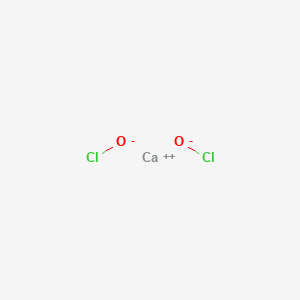



1. Calcium Oxychloride
2. Chlorinated Lime
1. 7778-54-3
2. Calcium Hypochloride
3. Hypochlorous Acid, Calcium Salt
4. Bleaching Powder
5. Chlorinated Lime
6. Hypochlorous Acid, Calcium Salt (2:1)
7. 11dxb629vz
8. Pittchlor
9. Pittcide
10. Pittclor
11. Sentry
12. Chemichlor G
13. Chlorine Of Lime
14. Solvox Ks
15. T-eusol
16. Chlorolime Chemical
17. Caswell No. 145
18. Hth (bleaching Agent)
19. Chloride Of Lime(dot)
20. Calcium Chlorohypochloride
21. Calcium Chlorohydrochlorite
22. Hipoclorito Calcico
23. Hipoclorito Calcico [spanish]
24. Bleaching Powder(dot) (van)
25. Chlorinated Lime(dot) (van)
26. Calcium Dihypochlorite
27. Ccris 9132
28. Hsdb 914
29. Hypochlorite De Calcium [french]
30. Hypochlorite De Calcium
31. Einecs 231-908-7
32. Nsc 21546
33. Un1748
34. Epa Pesticide Chemical Code 014701
35. Un 1748
36. Unii-11dxb629vz
37. Calcium Hypochlorite Mixture, Dry (dot)
38. Calcium Hypochlorite Solutions
39. Calcium Hypochlorite [hypochloride Salts]
40. Calcium Hypochlorite Solutions (15% Or Less)
41. Chlorinated Lime (jp17)
42. Ec 231-908-7
43. Calcium Hypochlorite Solutions (more Than 15%)
44. Chlorinated Lime [jan]
45. Chembl2251447
46. Dtxsid1029700
47. Chebi:31342
48. Calcium Hypochlorite [mi]
49. Chlorinated Lime [who-dd]
50. Calcium Hypochlorite [hsdb]
51. Calcium Hypochlorite [inci]
52. Akos015848494
53. Akos015902937
54. Db-023010
55. D01727
56. Q407300
57. Calcium Hypochlorite, Dry Or Calcium Hypochlorite Mixtures, Dry With >39% Available Chlorine (8.8% Available Oxygen)
58. Calcium Hypochlorite, Dry Or Calcium Hypochlorite Mixtures, Dry With >39% Available Chlorine (8.8% Available Oxygen) [un1748] [oxidizer]
| Molecular Weight | 142.98 g/mol |
|---|---|
| Molecular Formula | CaCl2O2 |
| Hydrogen Bond Donor Count | 0 |
| Hydrogen Bond Acceptor Count | 2 |
| Rotatable Bond Count | 0 |
| Exact Mass | 141.8901255 g/mol |
| Monoisotopic Mass | 141.8901255 g/mol |
| Topological Polar Surface Area | 46.1 Ų |
| Heavy Atom Count | 5 |
| Formal Charge | 0 |
| Complexity | 2 |
| Isotope Atom Count | 0 |
| Defined Atom Stereocenter Count | 0 |
| Undefined Atom Stereocenter Count | 0 |
| Defined Bond Stereocenter Count | 0 |
| Undefined Bond Stereocenter Count | 0 |
| Covalently Bonded Unit Count | 3 |
Only ca. 50% is excreted mainly with the urine followed by excretion with feces. /Sodium hypochlorite/
OECD SIDS for Calcium Hypochlorite (CAS RN 7778-54-3). Available from, as of August 27, 2013: https://www.inchem.org/documents/sids/sids/7778543.pdf
Most of the data for toxicity of this substance by the oral route came from studies performed with sodium hypochlorite or chlorine gas. In biological systems, characterized by pH values in the range of 6-8, the most abundant active chemical species is HClO, in equilibrium with ClO-. Such available chlorine is readily absorbed via the oral route and distributed into plasma, bone marrow, testis, skin, kidney and lung. /sodium hypochlorite/
OECD SIDS for Calcium Hypochlorite (CAS RN 7778-54-3). Available from, as of August 27, 2013: https://www.inchem.org/documents/sids/sids/7778543.pdf
It is well known from studies on HClO in inflammation processes that HClO is not enzymatically metabolised and its (bio)transformation readily occurs through direct reactions with organic compounds or with other chemicals present in the cellular environment, including hydrogen peroxide. The toxicokinetic study showed that chloride ion accounted for >80% (36)Cl radioactivity present in rat plasma. /Hypochlorite/
OECD SIDS for Calcium Hypochlorite (CAS RN 7778-54-3). Available from, as of August 27, 2013: https://www.inchem.org/documents/sids/sids/7778543.pdf
Hypochlorous ions are physiologically present in the human body, being formed by white blood cells (neutrophils and monocytes) as a powerful antimicrobial agent during inflammation process. When the recognition of "non-self" proteins in an invading micro-organism triggers the immune response, the enzyme myeloperoxidase located in mammalian neutrophils catalyses hypochlorous acid formation trough the oxidation of chloride ion in combination with hydrogen peroxide. The endogenously formed hypochlorous acid plays a key role in the process of phagocytosis through which bacteria are killed. Due to its potent cytotoxic action, hypochlorite is also responsible for neutrophil-mediated tissue damage associated with the inflammatory response. Its high efficiency as antimicrobial agent is associated with the lack of a catalytically active detoxifying mechanism for HOCl in both bacteria and mammalian cells. Although it has been suggested that HOCl-induced cytotoxicity can be associated to the degradation of a number of functionally important molecules the primary mechanism of action is still not fully elucidated. /Hypochlorite/
OECD SIDS for Calcium Hypochlorite (CAS RN 7778-54-3). Available from, as of August 27, 2013: https://www.inchem.org/documents/sids/sids/7778543.pdf
